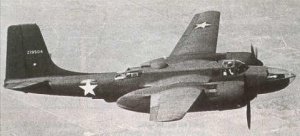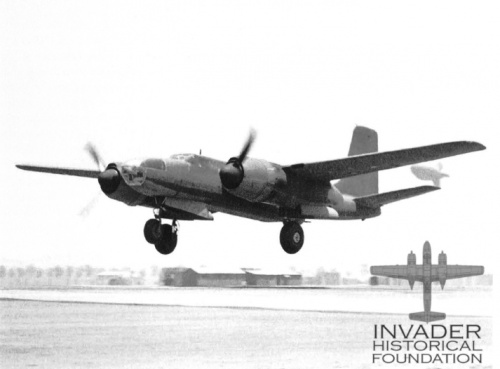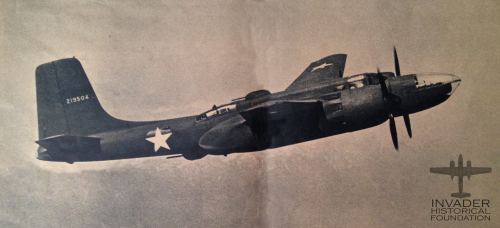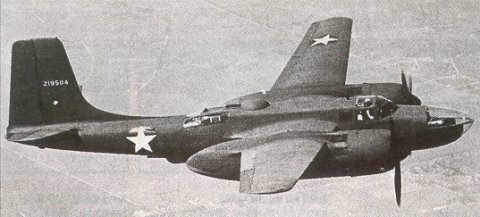41-19504
| XA-26 Invader | |||
|---|---|---|---|
| Builders: Douglas Aircraft Company | |||
| Operators: United States Air Force | |||
| Ordered 1941 | |||
| Number Built: 1 | |||
| First Built: 1942 | |||
| GENERAL CHARACTERISTICS | |||
| Type: Light Attack Bomber | |||
| Dry Weight: - | |||
| Wet Weight: - | |||
| Length: 51' 3" (15.24 m) | |||
| Height: 18' 6" (5.64 m) | |||
| Wingspan: 70' (21.34 m) | |||
| Wing Area: 540 Sq. Feet (50.17 m²) | |||
| Speed: - | |||
| Max Speed: - | |||
| Ceiling: 22,100 feet (6,700 m) | |||
| Powerplant: 2x Pratt & Whitney R-2800-27 | |||
| Horsepower: 2,000 | |||
| Fuel Capacity: - | |||
| Range: - | |||
| Crew: 2 | |||
| Passengers: 1 | |||
| ARMAMENT | |||
| Nose Guns: None | |||
| Dorsal Turret: None | |||
| Ventral Turret: None | |||
| Payload: 6,000 lbs | |||
See also: List of Invaders by Serial Number
This plane was the first working A-26 Prototype to be fully operational. In July of 1941 Douglas built a full-sized wooden mock-up of the plane with dummy weapons to pitch to the Air Force. That initial display culminated in a contract for two operational prototypes - this plane, and 41-19505 (The XA-26A). Later, the Air Force added a third prototype, the XA-26B (41-19588).
This plane was constructed with a glass nose (many sources cite it as "glazed").
The Douglas XA-26 prototype first flew on 10 July 1942 at Mines Field, El Segundo, CA with test pilot Benny Howard at the controls. Flight tests revealed excellent performance and handling, but engine cooling problems led to cowling changes and elimination of the propeller spinners on production aircraft. Repeated collapses during testing led to reinforcement of the nose landing gear.
Having served its purpose, the plane was later written off 16 Mar 1943 at Los Angeles Municipal Airport, CA. Despite being built, tested, and then written off, it wasn't officially accepted by the Air Force until Feb 1944.
This plane served as the prototype for what would become the C model Invader - those equipped with glass noses to aid in bombing. One observable difference between the prototype models and the production models was the "propeller spinner" - the cone-shaped piece in the middle of the propeller blades. The prototype units were equipped with this feature, but none of the production models had them.
Operational History
Test flight on 10 JUL 1942 at Mines Field, El Segundo, CA. Purportedly the plane made addition test flights, but the exact dates of these fights is not known to me.
Accidents
16 MAR 1943 This plane was listed as severely damaged in a landing accident at Los Angeles Municipal Airport. The pilot was Max A. Constant. He survived the crash.
16 APR 1945 This plane was involved in a Taxi accident due to mnechamical failure at the Murroc Field Test Area. It was moderately damaged. The pilot was William H. Connell. He survived the crash.
Known Crew
- Ed Heinemann - Designer
- Robert Donovan - Designer
- Ted R. Smith - Designer
- A.M.O. Smith - Aerodynamist
- Benny Howard - Test Pilot
- Max A. Constant - Test Pilot
- William H. Connell - Test Pilot
Disposition
This plane was purpose built for testing. Upon completing its mission it was retired from service. Some sources list this plane as subsequently written off 16 MAR 1943. This date coincides with an accident at Los Angeles Municipal Airport which lists the plane as severely damaged. However, it was involved in another accident in APR 1945, so it must have remained in service until at least that time.
Images
Luckily, being a prototype model, there are many images of this plane. This Prototype was the only prototype version to feature a glass nose. The other two had solid noses.
The XA-26 Prototype during takeoff, 10 JUL 1942.
The XA-26 Protoype in flight.
The XA-26 Protoype in flight.
Sources
- Douglas A-26 Production List
- United States Air Force Accident Reports
- Francillon, René. McDonnell Douglas Aircraft Since 1920: Volume I. London: Putnam, 1979. ISBN 0-87021-428-4.
- Smith, A.M.O., "High-Lift Aerodynamics; the 37th Wright Brothers Lecture", AIAA paper 74-939, reprinted in the AIAA Journal of Aircraft, Vol. 12 No. 6, June 1975.
- Lednicer, David. The Incomplete Guide to Airfoil Usage. Champaign, Illinois: UIUC Applied Aerodynamics Group, 2010. Retrieved: 18 May 2011
- Mesko, Jim. A-26 Invader in Action (Aircraft Number 37). Carrollton, Texas: Squadron/Signal Publications, 1980. ISBN 0-89747-093-1.



